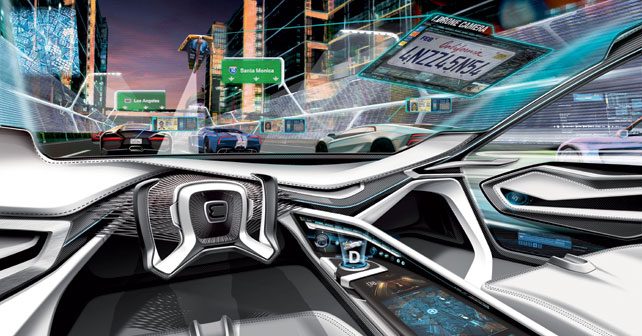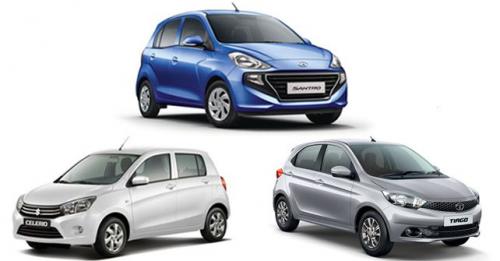Technology is revolutionising the way cars function. In the near future, cars will come fitted with large, integrated touch screens, allowing the driver to access a sea of information. And, soon, holograms will replace screens and information will simply float around in front of our eyes. For now, this may sound like science fiction – but it could become a reality sooner than you think.
The transformation of automobile instrumentation in the next few years is going to be truly mind-boggling. You’ll have screens across the dashboard, with gesture controls, and data projected on the entire windshield – which will act like a giant display screen. Believe it or not, everything you just read, or a large portion of it, will be very common in less than a decade from now.
If the future belongs to autonomous and connected cars, the driver will be relieved of many manual tasks – meaning he or she will be actively involved in controlling all the on-board information that will come through the car. Navigation, messages, e-mails, phone calls, image sharing via the cloud, information on points of interest, cultural or professional information – all will require larger display screens than the ones currently in use. So why not start using the entire instrument panel for various on-board functions?
It’s the direction in which many manufacturers have been gradually advancing of late. Mercedes showed something along these lines with its F 015 concept car that was revealed at CES 2015. They also showcased some future in-car connectivity solutions with the Concept IAA, revealed at the Frankfurt Motor Show in 2016. Both these concepts had large screens – the screen of the F 015 had been extended to cover the entire dashboard, while the ones in the Concept IAA were a little smaller. However, on the latter, what was even more striking was the centre console – which had a lightly curved glass that incorporated a touchscreen. The idea is to utilise all the surfaces of the cabin to make the car more interactive.
“New technologies in terms of screen displays – such as OLED, which are curved and ultra-thin – allow you to push the boundaries. Some of the in-car tech you see today was unimaginable a few years ago. Theoretically, you can have screens that simulate other materials, from wood to plastic. Although the costs of doing this are very high – at least as of now,” says Federico Giuliano, CEO of Made in Dreams, a consulting company specializing in design solutions.
While such screens are awaiting implementation, auto majors have decided to adopt interim solutions. Audi, with its virtual cockpit, has chosen to enlarge the size of the instrument cluster – making it a high definition display. Tesla has filled up the entire space on the centre console with a touch screen as big as two tablets. Volvo has placed a vertical screen in the centre of the dashboard of the new XC90 – mimicking an iPad or a big mobile phone. “A touch screen that controls all the functions saves costs for car manufacturers – this way they can avoid fitting different knobs and buttons. It also helps save the costs of installing the movement mechanisms of retractable screens,” explains Giuliano.
INSTANT SHARING
All the design efforts and resources that manufacturers are injecting into developing this human-machine relationship also translates to new job opportunities. The Peugeot-Citroen group saw an increased number of employees (from 5 to 60 people in three years) in its technical department who study graphic software to develop a car’s on-board instrumentation. Similarly, Jaguar Land Rover is in the process of hiring 50 engineers for its Innovation Incubator programme – an initiative born in Portland, in the United States, to promote and support the development of new software dedicated to the automotive industry.
JLR will select 120 start-ups to work with between now and 2025 – one among which is Vonsor, a service that allows video uploads from multiple cameras in cars, which can be shared on social media. The company is already developing a system that will allow drivers to shoot movies through external and internal cameras mounted on the car, edit them using the on-board touch-screen and immediately share them on social media, like Facebook or Instagram. “The application is in line with the demands of the new social generation, which loves to capture their experiences on their smartphones and share them,” says Justyn Baker President of Vonsor.
Adding these many functions requires simplifying on-board controls. BMW and Mercedes, are already studying the benefits of using gesture controls in a car. While BMW has already launched this technology on the new 7 Series, Mercedes is being more cautious and is still testing the technology.
THE STEERING WHEEL AS A DOCTOR
One area that still needs to be explored is incorporating touch controls on the steering wheel. “I imagine a scenario where all the buttons on the steering wheel will be replaced by a touchpad, which will be able to react to different levels of finger pressure,” says Giuliano. Benefits? Well, cost savings for one (no need for buttons), as well as a neat-and-clean design with fewer distractions. The steering wheel may also be used as a diagnostic tool to check the driver’s physical or mental condition by detecting pulse and body temperature.
Also, to reduce the distraction caused by screens, some manufacturers are mulling using the windshield of the car as a large screen – so that a large amount of information can be projected in the driver’s line-of-sight – much beyond what is possible with today’s head-up displays.
The dashboard of the Tesla Model S is a transitional form between today’s technology and tomorrow’s world – the big touch-screen contrasts somewhat with the classic design of the passenger cabin. The larger illustration on the left is from a BMW study three years ago that previewed what a police car would look like in 2025.
LIKE BEING AT THE CINEMA
With autonomous driving systems, the windshield simply becomes a canvas that can be used as a large display screen – as demonstrated by the ‘self driving’ Mercedes F 015 concept, which was showcased at CES 2015. It features an automated, digital cockpit, where screens reside even in the door panels. They can be used for entertainment, as well as to display what lies outside the vehicle – as if they were, in fact, transparent.
FULL SCREEN MODE
Thanks to the use of sophisticated software and graphics, as well as technology to mirror your smart phone, the screens inside the car are slated to become increasingly important – all of which will be made possible by new materials and technologies. Buttons will be reduced to a minimum, if not eliminated completely – replaced by touch-controls and backed by sophisticated voice systems.
This Kia KV7 concept of 2011 was a pioneer in terms of the integration of display screens and interior trim. The entire dashboard featured interactive LED lighting, while all the functions were controlled by a centrally mounted mouse.
On the Aircross concept, Citroen provided two screens side-by-side above the centre console. The one on the right can slide along a track on the dashboard to position itself in front of the passenger if and when needed.
The Mercedes Concept IAA, revealed at the 2105 Frankfurt Motor Show, had two large rectangular screens made to look like one on the dashboard – one in place of the instrument cluster and the other above the centre console. There was also a curved touchscreen in the centre console.
With four OLED screens (including one for the rear passengers), the Quattro e-tron concept is an evolution of the virtual cockpit that equips the latest Audi models. Steering wheel spokes and tactile surfaces are profiled to handle various functions.
GESTURE CONTROLS
Gesturing while driving may soon become commonplace. Mercedes is studying gesture controls (below), while BMW has already adopted it successfully. The new 7 Series (bottom right) has a 3D sensor in the instrument panel, which is able to discern between six different gestures. So, you can answer the phone or a message by simply pointing at the screen with your index finger and retracting your hand. By sliding it to one side, you can reject an oncoming call or close applications on the screen. All these functions, of course, are still available via the traditional BMW iDrive interface.
BARRIERS?
What about technical barriers? For now, there are many. Ranging from the variability of natural lighting and temperature variations of the windshield to the difficulty of projecting images in a suitable size within a confined space, such as the cabin of a car. Yet, the idea of a head-up display extended to the windscreen that provides a range of information – which you can view without taking your eyes off the road – is particularly interesting to all car manufacturers.
The Mercedes F 015 concept offers information on a large screen on top of the dashboard, rather than on the windshield itself. It’s designed in such a way that it needs only a slight change of focus of the human eye when the car is in motion.
Jaguar Land Rover is working on several ideas in the realm of augmented reality. In this picture, external cameras send images that are projected on the A-pillars – making them virtually transparent. The software also specifically identifies pedestrians and other hazards on the road.

© Riproduzione riservata




































Write your Comment